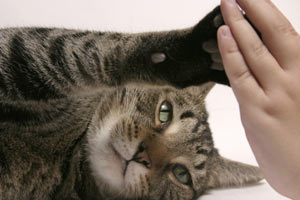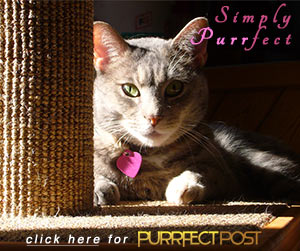Declawing Cats: Banning Declaw Surgeries

Increasingly, bills aimed at banning declaw surgeries in cats are being introduced at city and state levels. The Humane Society of the United States and the American Society for the Prevention of Cruelty to Animals oppose declawing and support making such bills into laws.
What Is Declawing?
A declaw surgery is a procedure in which the claws of an animal are permanently removed. This is most often performed in cats because they have normal scratching behavior that may damage belongings in homes.
In order to permanently remove a cat's claws, a surgical amputation is performed that removes the entire last bone of the toe back to the first joint, severing the muscles and tendons that control the claw's extension and retraction. Sometimes, the bone is cut through instead of removing the digit at the joint.
Why Do Some Believe That Declawing Should Be Banned?
There are seven main reasons that many people believe declawing is inhumane and that the majority of cats should not undergo a declaw procedure:
- Declawing is generally done for the benefit of humans, not for a medical condition. Declawing is a surgical procedure that is done to decrease damage to furniture and other belongings rather than for the medical benefit of the cat.
- Declawing is painful. A declaw surgery involves 10 amputations (18 if all four paws are declawed). The cat immediately has to walk on these wounds after the surgery. It is a painful recovery period. Also, some cats have long-lasting evidence of pain manifesting as limping after declaw surgery, sometimes permanently. Some people feel that this is nerve-induced pain.
- Cats need to scratch to maintain good physical and emotional health. Scratching is normal cat behavior. Cats scratch in order to stretch the muscles and tendons in their toes, paws, legs, and shoulders. They often do this when they first wake up from napping, in the middle of play-sessions when they are happy, and to release energy during times of stress. The inability to scratch can fundamentally affect a cat's well-being.
- Cats need their claws to climb and balance. Cats walk on their toes (they are digitigrade), not the soles of their feet like humans (we are plantigrade). The claws and last digit of the toe help provide balance. Declawed cats may be at higher risk of injury from falling.
- Cats use their claws for defense. Cats are safest indoors. However, sometimes they escape or are allowed outside. A declawed cat is much less able to defend himself against other cats, dogs, or wild animals that he might encounter outdoors.
- Declaw surgery carries a relatively high risk of complications. Hemorrhaging is a significant risk during declaw surgery. The procedure also requires anesthesia, which is always at least a minor risk.
- Complications after surgery are also relatively high with declaws. There is a risk of infection during the healing process, since cats must use their feet to walk around and to deal with litter, urine, and feces. Improper healing (opening of the wounds), claw regrowth (this sometimes happens inside the skin and isn't immediately visible as a problem), and long-term nerve pain are all common occurrences after declaws.
Are There Places Where Declawing Is Already Banned?
There are eight cities in California where cat declawing is currently banned. Declaw surgeries are also illegal in England, Scotland, Wales, Italy, France, Germany, Austria, Switzerland, Norway, Sweden, Netherlands, Northern Ireland, Ireland, Denmark, Finland, Slovenia, Portugal, Belgium, Spain, Brazil, Australia, and New Zealand.
Are There Times When Declawing is Necessary?
Most experts agree that there should always be provisions in any declaw banning legislation for medically-necessary declaw procedures. These situations might include the need to remove a deformed claw.
Alternatives to Declawing
- Scratching posts. Scratching is normal cat behavior. Providing your cat with scratching posts that offer him strong, stable surfaces that are made of a pleasing material for cats to scratch and enough height for climbing and perching will greatly decrease his desire to scratch other surfaces.
- Soft Paws. Developed by a veterinarian, Soft Paws are nail caps that fit over your cat's claws. They do not interfere with your cat's normal scratching behavior, but they protect the scratched surface from damage. They are non-toxic, easy to apply, and come in a variety of designs and colors.
- Training. Don't use your hands to wrestle with your cat or kitten. Cover furniture with foil or double-sided tape while teaching your cat where the appropriate scratching spots are. Use catnip and wand toys to entice your cat to use his scratching posts. Praise your cat when you find him scratching the post. DO NOT punish him for scratching other surfaces. This will increase his stress level and could lead to more scratching of inappropriate surfaces.
- Nail trimming. Keeping the hooks at the end of your cat's nails trimmed off will minimize what damage he is able to do if he does scratch furniture or carpeting. These trimmers work well for cats.
- Lots of play keeps stress at bay. Providing your cat with lots of toys, especially those that mimic prey, like these, and setting aside daily time to interact and play with him will reduce any stress-related scratching that he may do. If you have a multiple-cat household, using Feliway, a compound that mimics the calming facial pheromone of cats, can help keep all the family's felines feeling stress-free.
You May Also Like These Articles:
Feline Myths and Misconceptions Part Three
Polydactyly: Why Some Cats Have Extra Toes
Substrate Aversions and Preferences
Benefits of Multiple Cat Scratching Surfaces
Feliway - A Useful Tool to Help Treat Stress in Cats
Notice: Ask-a-Vet is an affiliated service for those who wish to speak with a veterinary professional about their pet's specific condition. Initially, a bot will ask questions to determine the general nature of your concern. Then, you will be transferred to a human. There is a charge for the service if you choose to connect to a veterinarian. Ask-a-Vet is not manned by the staff or owners of CatHealth.com, and the advice given should not delay or replace a visit to your veterinarian.





